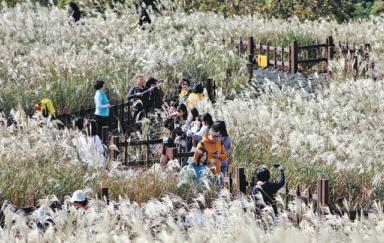Chinese visitors spur Asia-Pacific tourism


Visitors enjoy the Sangumburi Crater on Jeju Island, South Korea. XINHUA
Growth driver
Chinese tourism to Japan last year rose by 15 percent year-on-year, accounting for 25.6 percent of international arrivals, while overseas visitor spending in the country reached $40 billion, with Chinese contributing about one-third of this, Biswas said.
Chinese tourism has also had a significant impact on the South Korean economy, accounting for 46.8 percent of international visitors in 2016. In Australia, Chinese have become a key growth driver for the tourism sector, with 1.3 million arriving last year and spending $8.2 billion, up by 14 percent year-on-year.
"With Chinese annual per capita GDP forecast to continue rising significantly over the next decade, from an estimated $9,700 in 2018 to $22,000 by 2028, the Chinese tourism boom in the Asia-Pacific region looks set to continue over the long term," Biswas said.
The Pacific Asia Travel Association has forecast that Chinese tourists will form 40 percent of the Asia-Pacific market and will remain the key driver of Asian tourism growth in the foreseeable future.
Paul Yong, an analyst with DBS Bank in Singapore, said recently that the number of outbound Chinese tourists rose from 98.2 million in 2013 to 130.5 million last year to become the world's largest outbound market source.
"Yet less than one in 10 Chinese citizens has a passport," he said. "Imagine the sheer potential for growth as passport penetration catches up with Japan (23 percent), the United States (41 percent) and Australia, where 56 percent of the population have passports."
MOST POPULAR
- 1 $39.7 billion worth of deals inked at Airshow China
- 2 China announces tax relief measures to stabilize real estate sector
- 3 A look at China's economy in October, 2024
- 4 Public holiday extension announced
- 5 China's NEV annual production hits 10 million milestone amid global carbon reduction efforts
Editors' Picks
 Infographic:
Golden jubilee of China-Brazil relations
Infographic:
Golden jubilee of China-Brazil relations
 Infographic:
A look at China's economy in October, 2024
Infographic:
A look at China's economy in October, 2024
 Infographic:
G20 at a glance
Infographic:
G20 at a glance
 Video:
Peru sees new port open
Video:
Peru sees new port open



